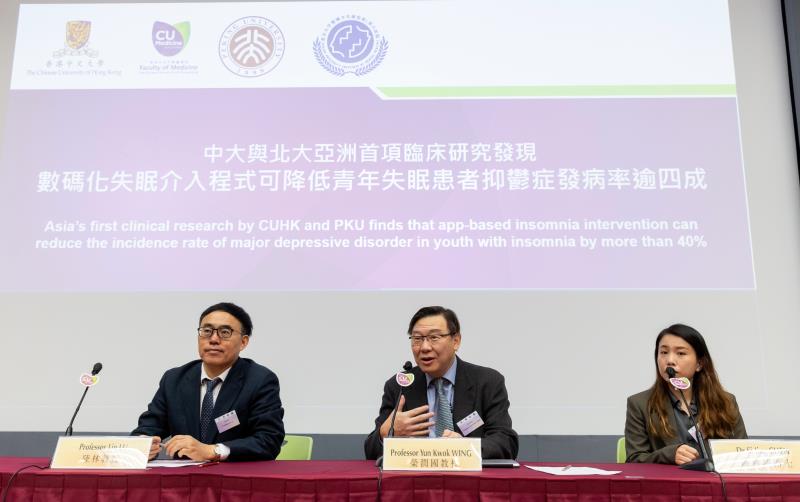App-based intervention cuts depression rate in youths with insomnia by >40 percent




 From left: Prof Lin Lu, Prof Yun-Kwok Wing, Dr Si-Jing Chen
From left: Prof Lin Lu, Prof Yun-Kwok Wing, Dr Si-Jing ChenApp-based cognitive behavioural therapy for insomnia (CBT-I) reduces the incidence of depression in youths with insomnia by >40 percent, researchers from the Chinese University of Hong Kong (CUHK) and Peking University Sixth Hospital have reported.
Insomnia occurs prior to and represents a risk factor for new-onset depression. CBT-I is an effective first-line treatment for chronic insomnia and is typically provided in a face-to-face format. [Curr Opin Psychol 2020:34:95-99; Sleep 2021;44:zsaa136] “However, the help-seeking rate among young insomnia patients in mainland China and Hong Kong is as low as 10 percent, highlighting low acceptance of traditional delivery format, which may increase the risk of depression among these patients,” said Professor Lin Lu, President of Peking University Sixth Hospital.
To evaluate the effectiveness of app-based CBT-I in preventing new-onset depression, the researchers conducted a randomized, assessor-blind, parallel group-controlled trial in 708 Chinese youths (mean age, 22.1 years; female, 57 percent) with insomnia disorder and subclinical depressive symptoms. Patients were randomized 1:1 to receive app-based CBT-I or app-based health education for 6 weeks. [PLoS Med 2025;22:e1004510]
After 12 months of follow-up, participants in the app-based CBT-I group had a significant 42 percent reduction in risk of incident depression (10 vs 18 percent; hazard ratio, 0.58; 95 percent confidence interval [CI], 0.38–0.87; p=0.008) vs the app-based health education group. The number needed to treat (NNT) to prevent depression was 10.9.
The rate of remission of insomnia disorder was significantly higher with app-based CBT-I vs health education at postintervention (52 vs 28 percent; relative risk, 1.83; 95 percent CI, 1.49–2.24; p<0.001) and throughout 12 months of follow-up.
Additionally, the app-based CBT-I group showed greater decreases in both depressive (adjusted difference, -1.0; 95 percent CI, -1.6 to -0.5; Cohen’s d, 0.53; p<0.001) and insomnia symptoms (adjusted difference, -2.0; 95 percent CI, -2.7 to -1.3, Cohen’s d, 0.78; p<0.001) vs the app-based health education group at postintervention and throughout 6 months of follow-up.
Insomnia was a mediator of intervention effects on depression. Postintervention insomnia symptoms accounted for 78 percent of the improvement in depressive symptoms at 6 months. Similarly, insomnia symptoms post–session 4 accounted for 74 percent of the intervention effect on depressive symptoms measured by Patient Health Questionnaire–8 (PHQ-8; excluding sleep item) postintervention. “There were no significant residual direct effects observed in both models, indicating that impacts of the intervention on depressive symptoms depended on its effects on insomnia,” added the researchers.
Notably, 84 percent of patients completed all six sessions of the app-based intervention. “The high completion rate revealed that a digital self-help treatment without face-to-face interaction is more readily accepted by the digital-native generation. This represents a breakthrough in the treatment of youth mental illness,” highlighted Dr Si-Jing Chen of the Department of Psychiatry, CUHK.
“Future studies should explore how to integrate digital insomnia intervention into clinical practice, especially in primary care, and examine ways to adapt this novel treatment to advance personalized prevention and early intervention in the community,” commented Professor Yun-Kwok Wing, Chairman of Department of Psychiatry, CUHK.